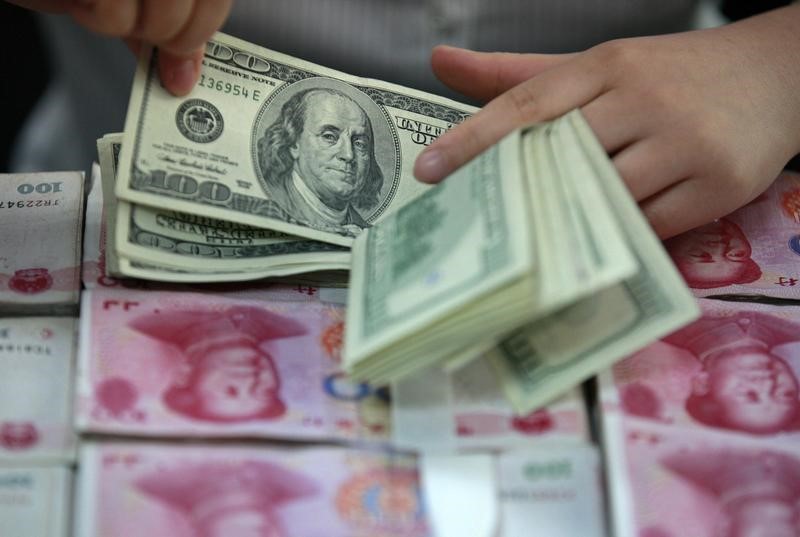
Top 5 Things to Know in the Market on Wednesday, May 27th
by Investing.comBy Geoffrey Smith
Investing.com -- The dollar hits a nine-month high against the yuan as tensions between the U.S. and China simmer and Hong Kong experiences another night of protests. The euro breaks through $1.10 for the first time in nearly three months after the EU Commission proposed a 750 billion-euro recovery fund for the bloc. Stocks are set to extend their rally but face reality checks from regional and national business surveys, while oil prices are consolidating ahead of the API inventories report later. Here's what you need to know in financial markets on Wednesday, May 27th.
1. Yuan falls to nine-month low
The dollar hit its highest level since September against the Chinese yuan as events threaten to escalate the political conflict between the U.S. and China. The yuan fell as low as 7.1773 in the offshore market, which is less tightly controlled by Beijing – within 0.5% of last September’s record low.
The House of Representatives is set to vote on a bill Wednesday that would sanction Chinese officials for human rights violations in the western – mainly Muslim - province of Xinjiang. The bill, which has already passed the Senate, would raise U.S. pressure on China without adding immediately to the economic pressure of a simmering tariff war.
The vote comes after two days of often violent skirmishes between protesters and police in Hong Kong against a new security law that would make it easier for Beijing to clamp down on opposition there.
2. Euro breaks $1.10 as EU proposes $825 billion recovery fund
The European Commission laid out its proposals for a 750 billion-euro ($825 billion) European Recovery Fund that greatly expands the ability of the EU to borrow against its own budget resources.
The Commission intends to distribute two-thirds of the fund as grants, rather than loans, in what represents a big step towards a more centralized European budget, with formalized transfers of wealth between member states. Its plans still face opposition from at least four member states – the Netherlands, Austria, Finland and Sweden – but has the crucial support of Germany, the biggest contributor to the bloc’s budget.
The euro broke through $1.10 for the first time since the end of March in response to the news, on perceptions that it will remove fat tail risks from eurozone member states such as Greece and Italy, who no longer seem economically strong enough to grow out of their current debt problems.
3. Stocks set to open higher; Chinese markets fall again
U.S. stocks are set to open higher again, extending a rally on Tuesday that was driven by increased faith in the strength and speed of the recovery from the Covid-19 lockdowns.
By 6:30 AM ET (1030 GMT), the Dow Jones 30 Futures contract was up another 347 points, or 1.4%, while the S&P 500 Futures contract was up 1.2%. With cyclical stocks increasingly returning to favor, the Nasdaq 100 Futures again underperformed with a 0.8% gain.
European stocks were also higher on the back of the European Commission’s proposals. The Stoxx 600 rose 0.8% to its highest in nearly three months.
However, mainland Chinese markets and the Hong Kong Hang Seng both fell again, amid the negative newsflow out of the two former British colonies.
4. Business surveys to give reality checks to rally
The U.S. markets will get some more up-to-date reality checks in the course of the day, with the Johnson Redbook retail survey at 8:55 AM ET and regional business surveys for May from both the Richmond and Dallas Federal Reserve Banks at 10 AM and 10:30 respectively.
The Fed’s own Beige Book survey of business conditions then comes out at 2 PM ET.
In between those events, the St. Louis Fed President James Bullard will speak at 12:30 PM.
5. Oil consolidates ahead of API data
Oil prices are consolidating, as the unrest in Hong Kong and the political rumblings between the U.S. and China prompt a little caution, after a week of sharp gains.
By 6:30 AM ET, U.S. crude futures were down 1.0% at $34.01 a barrel, while the international benchmark Brent was down 1.4% at $35.65 a barrel.
At 4:30 PM, the American Petroleum Institute will publish its weekly survey of U.S. crude inventories. Data published earlier in the week by the consultancy Seevol suggest another big draw on crude stocks ahead of the Memorial Day weekend.
Elsewhere, the International Energy Agency said in a report that it expects investment in the U.S. shale sector to fall by 50% this year in response to the earlier price collapse and the uncertain outlook for a recovery.